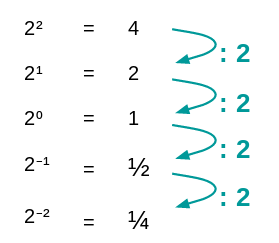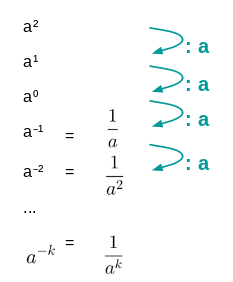Powers
Powers are a shortened notation for multiplying a number by itself several times.
Example: You may write as (with power 3).

The exponent, in this example , describes how often a number is multiplied by itself.
In general, any number without an exponent has automatically an exponent of 1 (beacuase if you multiply one time by itself, you exactly get ).
That is, .
The exponent is usually omitted in this case.
Example:
If you exponentiate any number by , you always get . The only exception is . In some books, "" is not defined. In others, it is set . We will also adopt the convention .
The convention is a bit dangerous, since one could also argue that for any natural number , we have . So there are also arguments to define that is equal to . However, this definition is usually not used.
If in more advanced mathematics, you want to write polynomials using summation signs, for example, for a third degree polynomial, then you get
Here, for the corresponding summand is and should be equal to . In order for obtaining also for , it is convenient to set .
Base and exponent
The number to be multiplied by itself is called the base, the number of self-multiplications is called the exponent. Both together are called a power. If the exponent is , it is also common to speak of an "-th power" or to say that the base is taken "to the power " or "to the ".

Powers with negative base
If you take a power of a negative number, the result may be positive or negative:
If the exponent is even, then the result becomes positive.
if the exponent is odd, then the result stays negative.
Examples:
Let's calculate explicitly:
The term is positive because the number is greater than zero. For the term , we can use that "minus times minus equals plus":
So generally,
Now if is an even number, then is positive, and if is an odd number, then is negative. Thus, is also positive if is even, and negative if is odd.
Powers with negative exponents
How can you interpret ?
If the exponent is reduced by one, that means that the number is divided by the base. For positive exponents you already know this, and it is also true for negative exponents.

Here you see the division procedure for a general number . Starting from , after division steps, you will find the above formula.

Examples:
Rational Exponents
Numbers thathave a rational number (i.e., a fraction) as an exponent can be identified as a root:
Thus, for the "standard" square root:
Examples:
Calculating with powers
In the article Power Laws you can learn some useful rules that allow you to do calculations with powers.
Exercises
Loading
You can find more exercises in the following folder::
Exercises: Simple fractions